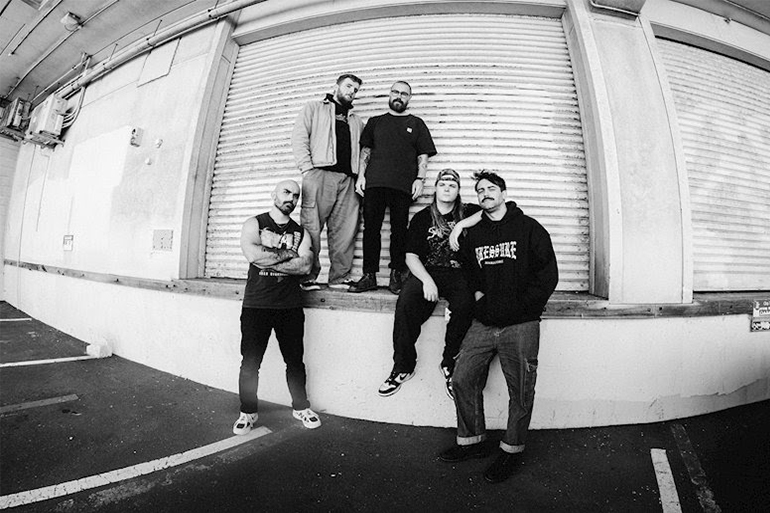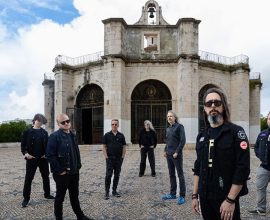Brainwave: “Nothing happens in a vacuum, right? Our personal struggles are all connected to political issues”
Brainwave return with Ill Intent, a visceral and uncompromising album that dives headfirst into themes of hopelessness, loss, and everyday brutality. In this interview, the band opens up about the deeply personal experiences and societal tensions that shaped the record, the addition of Ian Moore as the fifth member and how it transformed their sound, and the collaborative spirit within New Zealand’s hardcore scene.
By Sandra Pinto
From the political undercurrents woven into the lyrics to the striking artwork by Cam Parker, Brainwave reflect on the challenges, growth, and resilience that define both the album and their live performances.
You’ve described Ill Intent as an extremely personal record. What was the driving force behind the themes of hopelessness, loss, and everyday brutality, and how did these emotions shape the music?
We were all facing some challenges during the writing process. Whether at work or in other aspects of our personal lives, the album became an outlet for those struggles. Things like not achieving the goals we wanted in life, feeling disconnected, isolated, and atomised. This is also all of course in the aftermath of the COVID pandemic and the polarisation that has wrought. Society itself seemed to be breaking down.
We were also all profound affected by the genocide being inflicted on the people of Gaza by the state of Israel and the escalation of violence in the West Bank. It was also frustrating that many of our peers seem to have failed to recognise that daily horror and systemic forces pushing the region to the brink. Overall, just a general dissatisfaction with the state of the world, but also a sense that you can conquer your doubts and prove your detractors wrong and, hopefully, make things slightly better in the process.
This album marks a significant turning point for Brainwave, both musically and in terms of lineup changes. How did the addition of Ian Moore as the fifth member influence the sound and dynamic of the band?
Brainwave initially started as a five-piece, but we had been playing as a four-piece for a while and had started recording III Intent before Ian joined. We quickly realised that to execute the sound we were laying down live, we would need to recruit a second guitarist. There are a lot of leads and divebomb parts where the rhythm is still going underneath. It just wouldn’t hit right live as a four-piece.
Ian is a friend of ours and has played in a bunch of Wellington Hardcore bands (Severed Beliefs, Piss Baby, Visions ov Hell), and has a Cybergrind project Deathtrippa. We asked him to play some shows with us over the New Zealand summer and eventually it was like “bro, you should just join”. Luckily for us he agreed and ended up tracking guitar for a number of the tracks on the album. His presence has also made a huge difference to our live show, just a far bigger, more layer sound.
With the blend of hardcore aggression and thrash crossover, you’ve drawn comparisons to bands like Drain, Mindforce, and Forced Order. How would you describe Brainwave’s unique sound, and what sets you apart from other acts in the scene?
Crossover is a super fun genre, but it can be a bit one-dimensional or formulaic if you don’t have something that sets you apart. Those bands – especially Drain and Mindforce – have a kind of boppy, fun element, and don’t take themselves super seriously. That’s definitely more of a hardcore thing than a metal thing. So we’re kind of a party band, but then Rob’s harsher vocal style adds a harder edge. Overall, we’re definitely firmly rooted in hardcore, but drawing on some metal influences.
The album art by Cam Parker is striking, balancing themes of despair and defiance. How did you work with him to ensure the visual elements of the album matched the message and tone of the music?
Cam was great to work with! We did a bit of a mood board for him, which drew on a lot of fantasy artists like Frank Frazetta, and outlined the themes around a lone warrior overcoming adversity, then pretty much let him have free rein. What he came back with was perfect!
Definitely check Cam out – @spiralwizard
You’ve mentioned that Ill Intent reflects a world tearing itself apart. Can you elaborate on how you’ve approached the political side of the album, and how it ties into the personal struggles explored in the songs?
Nothing happens in a vacuum, right? Our personal struggles are all connected to political issues. It’s clear that we no longer live in a neoliberal “end of history” moment. That means our personal struggles to find a sense of meaning and fulfillment in the world are continually
influenced by the ambient political environment, not just the invisible hand of the market. Further, there are times, the last four or five years being a perfect example, when that ambient political noise bursts through and your personal issue suddenly becomes inherently political – how am I going to put food on the table, can I access the healthcare I need, how can I watch a genocide happen on my feed day after day. Our personal struggles are always connected to wider political issues.
The process of recording Ill Intent sounds like it was a transformative experience. What were some of the key lessons you learned about yourselves and each other during the making of the album?
The main thing we learnt is that we actually could do this, that making an album wasn’t just a thing for other bands. That can be a big mental hurdle in this genre. There was a lot of learning by doing, trial and error, but we got there. There are certainly things we would do differently next time, but without going through the process we wouldn’t even know what those lessons were.
Also, being a little bit older and working in the ‘real world’ of office jobs and project-based work meant we could make use of a lot of those techniques, too. Spreadsheets, Gantt charts, even things like sprints and scrums to get a single release done. It would be hard to imagine getting this album done without our Thursday night stand-up!
You’ve collaborated with several guest musicians on this record, including members of Lucre, Molosser, and Martial Law. How did these collaborations come about, and what do they bring to the final product?
Those collabs were all super organic. Aaron (Lucre), Arnold (Molosser), Sam (Martial Law), and Luke (Xile) are homies of ours from way back. It was really important for us to showcase the New Zealand hardcore scene, too, which influenced our choices. Each of them also brings something unique to the track they’re on. Aaron and Arnold are both on the opener, ‘No Mercy’. Aaron’s vocals have a ferocious, almost deranged quality in the second verse, then Arnald drops some absolutely crushing gutturals in the breakdown at the end of the track. Sam’s verse in ‘Sad Man’s Parade’ totally levels the song up. His clean style provides a notable contrast to Rob’s delivery.
Luke’s section in ‘Ill Intent’ has an almost hip-hop feel. The drums play an accented 16th note pattern, different layers of guitars are coming in and out, and the two vocal parts are essentially trading verses. 90’s hip-hop was definitely a big influence on the album.
Lewis Noke-Edwards took on the producer, mixing, and mastering duties for the album.
What was it like working with him, and how did his involvement shape the sound of Ill Intent?
Lewis is great! Our mates in Soul Void put us onto him. They’d been working for a while and when we did a split with them, Horrifying New Form (2022), it was a natural fit to get him to do the mix and master for our tracks on that release. He then did the mix and master again
on our Summer Promo ‘23 (2023).
For Ill Intent we wanted to have an outside influence on board to both push us and check our instincts. There wasn’t really any other person for the job in our minds. So we set-up regular meetings with Lewis. We’d send him demos beforehand and then he’d rip them apart, recombine them, add things or take them away. He was never pushy and was always clear that we didn’t have to do what he was suggesting, in fact his ideas might make us realise that we were on the right track initially. But there are definitely a number of ideas on the album that we would never have thought of on our own and that make the songs much stronger. In particular, there were a number of song structures, transitions, and leads that he contributed to.
It’s cool as well because when he comes to mix the songs, Lewis already knows them and gets what we are trying to achieve. He’s been ruminating on them and isn’t starting from a blank page.
The ten tracks on the album are packed with intensity and urgency. Was there a particular song or moment during the recording process that felt like a breakthrough for the band?
There are two tracks that were milestones for us in the writing process. ‘The Truth’ was written pretty early on and became a real reference point for the other tracks. It had elements of our previous releases but also some different components – the overall structure and leads were quite different for us. So as we continued writing, we would often refer back to that track to check that the newer material meshed with it. The other was ‘Sad Man’s Parade’. From early in the writing process we were exploring ideas for something a bit more “epic”, that incorporated new elements for us and pushed us forward. We sent an early demo of ‘Sad Man’s Parade’ to Lewis and it came back with these percussion samples all over it, picking up on this Roots-era Seputera kind of vibe. So we finished the song off with this vision of incorporating those elements when it came to recording.
Ateo Buhne, a local musician who plays in a bunch of bands like the Afrobeat Star Time and the D-Beat crusters Dole Bludger, was gracious enough to agree to do the auxiliary percussion for us, and we spend a crazy afternoon recording about 50 layers of various drums, tambourines, shakers, and other noise makers with him. The end result was something that was pretty out the gate for us and has been received really positively. There probably weren’t any breakthrough moment’s, but cultivating the discipline to plan out and then work through a process to finish the project played a huge part in producing the end result.
Given the album’s mix of personal and political themes, how do you want Ill Intent to resonate with listeners? What do you hope they take away from it?
Folks have definitely been responding to the personal themes. Songs like ‘Lost My Way’ are really just about feeling stuck, not knowing which path to take, or how to move forward. That’s definitely a theme that seems to resonate. But if there is anything we hope people take away, it's what we mentioned earlier – that those personal struggles are inherently connected to political issues.
New Zealand’s hardcore scene has seen a rise in recent years, and Brainwave has become a standout act. How has the local scene influenced your sound, and how do you see the New Zealand hardcore community growing?
Currently, the scene in Wellington is really strong and there are so many great bands, with more forming all the time. Check out Lucre, Standover, Stress Ghetto, Shuriken, Visions ov Hell, Molosser, Ruminari, Marmablade, Vortekke, Cryfor. The list goes on. One of the
inspiring things is that everyone is doing something different – from death metal to power violence, to goregrind. It’s just really vibrant and exciting to be apart.
A major part of why the Wellington scene has grown so much in recent years is down to the efforts of Start Today Crew putting on regular all ages shows and recently hosting their own fest, which included bringing over Horsepower from Naarm (Melbourne). Hardcore is a DIY genre and if you don’t have people doing that kind of work then the scene dies.
Widening that out to all of New Zealand, and again you see really strong scenes in Auckland and Hamilton, with things starting to grow in the South Island, too. Massive props to all Hamilton and Auckland bands currently holding it down – Martial Law, Drop Off Point, Brawler, Cease & Desist, Nuclear Blunt, Soul Void, Xile, Dredge, Take Hold, Moment of Truth. That's only a small selection.
It would be sick to see more New Zealand bands try and take things overseas. It’s hard work but doable. Xile are currently smashing it over in Europe playing with bands like Dying Fetus and Gideon.
Looking ahead, what’s next for Brainwave after the release of Ill Intent? Are there plans to tour or start working on new material already?
We’re touring the record across New Zealand throughout November. We’d love to make it over to Australia in the new year, it’s just finding a way to make that happen, for the stars to align.
We’re all keen to start working on new material pretty soon, too. This album was a long time in gestation and there were plenty of ideas left on the cutting room floor that could form the basis of a new project.
If you had to describe Ill Intent in one sentence, what would it be?
A violent, emotional, but laser-focused 28 minutes of modern crossover for both headbanger and two-steppers.
Finally, with such a raw and intense album, how do you translate this energy to the stage in your live shows? What can fans expect from your upcoming performances?
That’s something we’ve been thinking really hard about and we’re definitely aiming to translate that intensity to a live environment. That means the flow of the songs is really important, and we have a couple of extra bits that get added in to keep it moving. Overall, we’re aiming to deliver a relentless set from start to finish.
Bandcamp here
Spotify here





